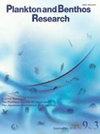Umbrella of Mastigias papua (Scyphozoa: Rhizostomeae: Mastigiidae): hardness and cytomorphology with remarks on colors
IF 0.6
4区 生物学
Q4 MARINE & FRESHWATER BIOLOGY
引用次数: 1
Abstract
Mastigias papua, known as the golden (or spotted) jellyfish, is an epipelagic jellyfish widely distributed in the warm waters of the West Pacific. This jellyfish has a brownish body, owing to zooxanthellae, and white spots. We measured the maximum force to pierce the umbrella, which averaged 94–144 mm in diameter, to evaluate the hardness of M. papua, and returned a range of 0.14–0.45 N. Correlation analyses indicate that when the M. papua medusa grows (i.e., becomes heavier), the umbrella becomes larger in diameter, as well as thicker and harder within the size range we examined. However, a significant relationship between the hardness of the umbrellar apex and the thickness of the umbrella was not obtained. White spots are comprised of loose aggregates of mesogleal cells containing reflective granules. Since the white spots and the transparent parts were not significantly different in hardness, the spots were unlikely to strengthen the umbrella. The primary function of the spots may be the shading of solar radiation. Most of the zooxanthellae are located in mesogleal cells, and often beneath the exumbrellar epidermis. Therefore, light shading by white spots may be unnecessary for the zooxanthellae in mesogleal cells.马齿苋伞(孢子虫纲:根形虫科:马齿苋科):硬度和细胞形态,并附注颜色
巴布亚水母,被称为金色(或斑点)水母,是一种广泛分布在西太平洋温暖水域的上层水母。由于虫黄藻,这种水母有棕色的身体和白色的斑点。我们测量了刺穿伞的最大力,平均直径为94 - 144mm,以评估巴布亚水母的硬度,并返回了0.14-0.45 n的范围。相关分析表明,当巴布亚水母生长(即变重)时,伞的直径变得更大,在我们所检查的尺寸范围内,伞的厚度和硬度也变得更厚。然而,伞顶硬度与伞顶厚度之间的关系并不显著。白色斑点由含有反射颗粒的中胶束细胞的松散聚集体组成。由于白色斑点和透明部分的硬度没有明显差异,因此斑点不太可能加强伞。黑子的主要功能可能是遮挡太阳辐射。大多数虫黄藻位于中胶细胞内,常位于伞状表皮下。因此,对于中胶细胞中的虫黄藻来说,白斑遮光可能是不必要的。
本文章由计算机程序翻译,如有差异,请以英文原文为准。
求助全文
约1分钟内获得全文
求助全文
来源期刊

Plankton & Benthos Research
Agricultural and Biological Sciences-Aquatic Science
CiteScore
1.30
自引率
0.00%
发文量
32
期刊介绍:
Plankton and Benthos Research is a peer-reviewed journal publishing quarterly original papers, reviews and notes dealing with any aspect of the biology and ecology of planktonic and benthic organisms and their interactions with the environment in any aquatic system, and is open to all scientists around the world. Submission of a paper is held to imply that it represents an original contribution not previously published and that it is not being considered elsewhere.
 求助内容:
求助内容: 应助结果提醒方式:
应助结果提醒方式:


